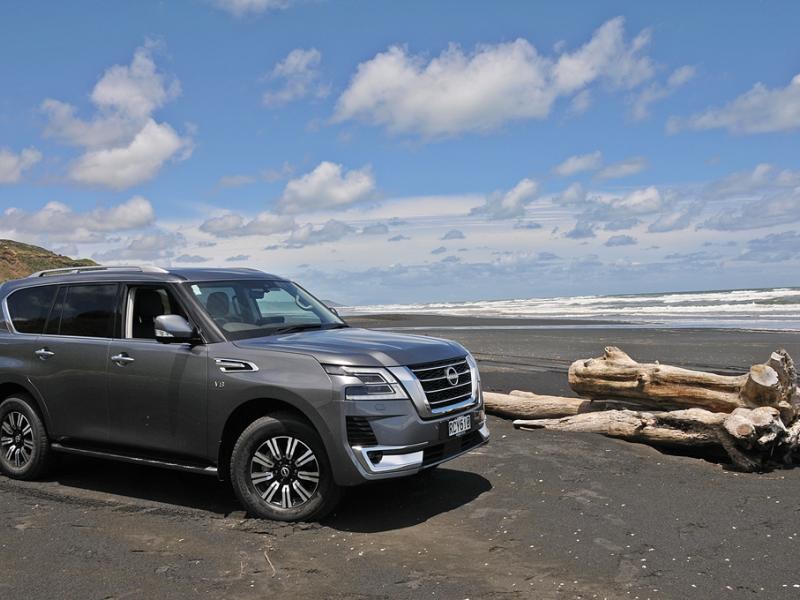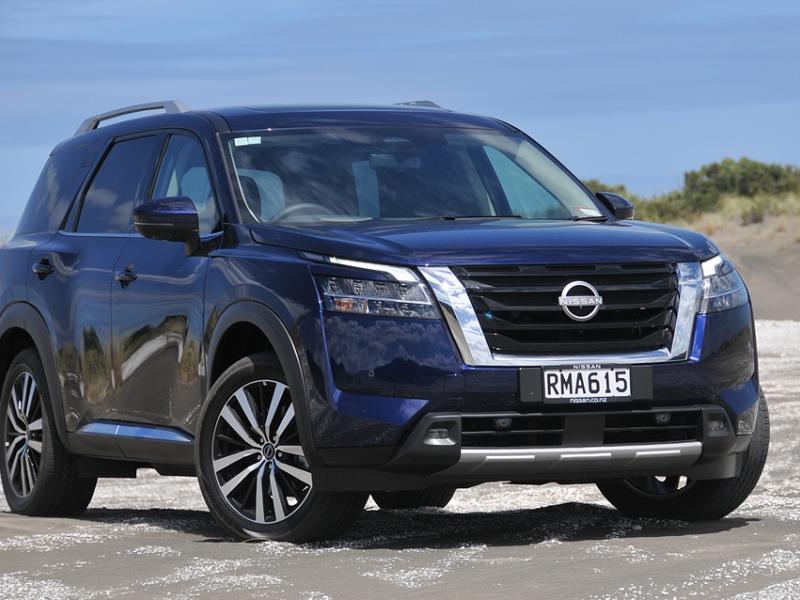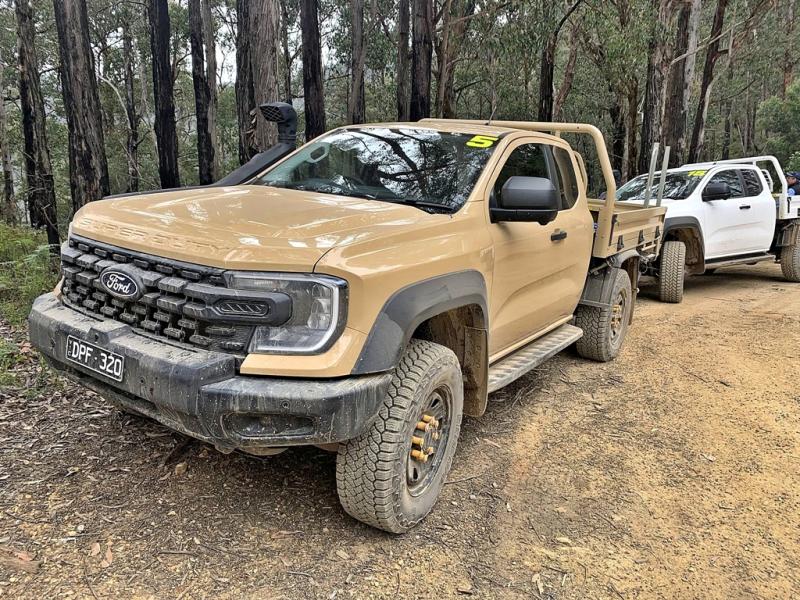Good old Ford eh? While other car companies play it safe the Ranger Raptor is all about performance, on as well as off the road. NZ4WD Editor Ross MacKay has the story. Photo by Mark Baker
It’s the question everyone askes when you climb down out of Ford’s new Ranger Raptor; ‘what does it go like?”
If I was asked this once in the week I spent driving in and around greater Auckland in Ford’s distinctively liveried metallic blue Raptor, I was asked it 100 times; at my local Z service station, in the car park at Hampton Downs, even mid photo shoot at Muriwai Beach.
Like the HSV SportsCat and SportsCat+ models there appears still to be a wee bit of confusion regarding the engine. Otherwise most people I spoke to knew that the Raptor was Ford’s range-topping ‘Tuff Truck’ and that it was supposed to be able to ‘leap tall sandhills’ in a single bound.
So, in the interests of keeping you reading I will say this; the new Raptor goes bloody well………….
It does because of three things;
1) The highly impressive new 157kW/500Nm 2.0 litre four-cylinder twin-turbo diesel engine/10-speed automatic transmission combination
2) A brilliantly conceived, calibrated and sorted, Fox Shox-equipped long travel coil-sprung suspension package and four-wheel disc brakes, and, the piece de resistance;
3) Ford’s push button, six-option Terrain Management System (TMS)
Size-wise
The Raptor is actually larger than a standard Ranger in every dimension, with an increase in length of 39mm, height of 58mm, and width, which is a whopping 331mm wider thanks to the increased track, which is now 1710mm.
Give them the old ‘knuckle-tap test’ and you will find that both the front and rear guards are made from composite materials to cope with the extra track width, suspension travel and bigger, wider 17 inch dia. alloy rims and 285/70 R 17 BF Goodrich tyres.
You don’t have to be a rocket scientist to twig that ground clearance is also up to 283mm, while the approach angle of 32.5 degrees, ramp over angle of 24 degrees, and departure angle of 24 degrees are also improved over the standard ute.
Coils all round
Ford has also seriously upgraded and reinforced the Ranger’s chassis for the Raptor, which incorporates new geometry to allow for greater wheel travel, while the rear end is now coil rather than leaf sprung up using a version of the Everest SUV’s coilover rear suspension with an integrated Watt’s linkage.
All this means that the Raptor has an imposed, high, wide ‘n handsome stance which makes it look, feel and ride more like its plus-sized big brother the Ford F-150 than its regular-size Ranger siblings
I’m as close to two metres in height as it is possible to get yet I found myself routinely using the die-cast aluminium side step and A-pillar grab handle to climb up into then down out of the cockpit.
Once inside the shape, material choice and trim is definitely a cut above even that of the Wildtrak with comfort, support and adjustability each getting a maximum MacKay tick.
I thought that the little red stripe on the steering wheel which marks the straight ahead position a nice touch. I also liked the fact that you can use the steering wheel-mounted paddles to change gear (usually down to gee things up a bit!) while still in D (Drive).
What I didn’t like was the fact that (like all volume production ‘flappy-paddle’ systems) they’re really only any use when you are driving in a straight line. Try using them when you are sawing away at the wheel off-road and you end up looking like an Octopus in a Drift comp………..
The other (minor in the overall scheme of things) thing that got on my wick when I was behind the wheel was now noisy the air con fan was. In a knockabout ute costing a quarter what the Raptor does I wouldn’t have an issue.
But frankly, on a top-of-the-line model costing the best part of $90K I would have expected if not Lexus, at least Toyota Prado, levels of noise from the air con system.
Pudding. Proof!
It’s in daily use that buyers will ultimately judge the Raptor on. And much like HSV’s modded Colorado the Raptor comes across as one very impressive piece of kit – with one proviso.
Start ‘er up (there’s now a button) and bowl off down the road (in D for Drive) and – to be brutally honest – I wouldn’t be surprised if many existing Ranger owners were left wondering what all the fuss is about.
Acceleration is smooth though hardly pulse-raising, and once ‘up on the plane’ the spring and damper settings appear so soft that the nose goes all fallopally under hard braking before bouncing back in the sort of classic ‘porpoising’ movement that used to bedevil old Nissan Navaras of my acquaintance.
AWOL as well is the standard Ranger’s sector-best, direct and wonderfully communicative steering action, in its place an old-skool steering box-style looseness which I initially too to be the necessary compromise due to the long travel suspension.
Silly me!
Silly me! What I was experiencing was the breadth of the electronic Terrain Management System. Normal – which optimises 101 different settings in the ultimate interests of fuel efficiency and comfort – is like the kill-joy ‘homologation’ setting designed (it would seem) by and for the fun Police.
Fortunately Sport (an altogether more Raptor-ish option) sharpens everything up to the point where if it were me, I’d use it all the time for my daily seal and gravel (2H) and (4H) and weekend farmland and sand (4L) missions.
There are also five more specific modes to fine-tune the power, grip steering response etc.
The first you might reasonably plumb for when things start to get a little sketchy in the traction department is Grass/Gravel/Snow.
The next, which I reckon should be called the ‘Kiwi farm option,’ is Mud/Sand, the third Rock, and the fourth (and ultimate performance one) the Baja.
I (as you do!) tried them all and – surprise, surprise – preferred the Baja one.
As long as you can carry some momentum Mud/Sand worked OK in ……mud and sand, though with such wide tyres you do tend to find the limits of grip before you do those of ground clearance…
What I eventually ended up with was a mix of new and old school – 4H in Sport mode with traction control switched off and the locking rear diff switched on.
Too easy!
In 2H and Sport mode it was simply too easy to overpower even the big wide standard BF Goodrich boots out back, resulting - on our private gravel test track (!!!!) – in huge pendulous oversteer slides, but little forward motion.
A quick (on-the-fly) swap to 4H sorted that out, though the huge grip now available with all for wheels pawing through the loose gravel and into the hard base below, would arguably chew those soft (and I must say impressively quiet) BF Goodrich hoops out tout suite!
So there you go, no mention of the price ($84,990 + On Roads) and scant mention of the things buyer supposedly ‘must have’ these days, like SYNC3 with Apple CarPlay and Android Auto smartphone compatibility and DAB auto!
Because?
Because the Raptor is the rarest of beasts, a factory-built Tuff Truck with real daily –drive credentials. There are probably better – not to mention considerably cheaper – work utes out there. But if you have both the wherewithal to buy one, and the time and inclination to enjoy exploring its many and varied capabilities, I don’t think you will disappointed.
In fact, as its various GT versions – from the original XW right thru to the ELs, AUs etc – of its Falcon four-door did for past generations of car nuts here and in Australia, I think the Raptor is going to do for whatever you want to call the current generation. And that is provide an uprated performance version of the company’s top-selling model for those who can afford it, and something for the rest of us, and those in generation to follow, to aspire to.
Marketers are all about the Millennials at the moment. Few will have close to $90K to spend on a ute at the moment, but many no doubt will be inspired by it. Which is why I came up with the headline, Ford’s Millennial Falcon (GT)!
SPECIFICATIONS
FORD RANGER RAPTOR
Engine: 1996ccc Bi-Turbo direct common rail diesel injection Max power 157kW @ 3750rpm, Max torque 500Nm at 1750-2000rpm
Transmission: 10-speed automatic, part-4WD w/4WD transfer case
Wheelbase: 3220mm
Track: 1710mm
LxWxH: 5398x2180x1873mm
Turning Circle 12.9m
Ground Clearance: 283mm
Unladen Weight: 2410kg
Payload: 758kg
Gross vehicle Mass GVM: 3,090
Towing: 2500kg braked.
Fuel Tank 80 litres
Economy: 8.2L/100km
Price $84,990+ORC
To read the full story in the February 2019 issue of NZ4WD go to Zinio.com (January 21) or purchase your own hard copy at the Adrenalin store.







